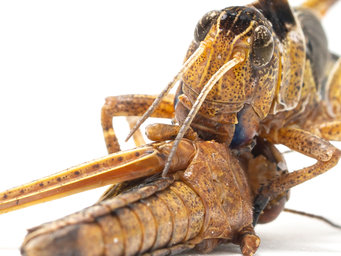Migratory locusts release a toxic substance to fend off their own conspecifics
In a new study in the journal Science, researchers from the Max Planck Institute for Chemical Ecology, together with partners from China and the University of Halle, Germany, show that the migratory locust Locusta migratoria produces the compound phenylacetonitrile (PAN) to defend itself against feeding attacks by conspecifics as population density increases. Cannibalism rates increased in locusts that could no longer produce PAN. The researchers also identified the odor receptor for PAN in the locusts. They showed in animals with a PAN receptor that was no longer functional that it is necessary for the perception of PAN and the suppression of cannibalistic behavior. The discovery of an anti-cannibalism pheromone offers new approaches for locust control (Science, May 2023, DOI: 10.1126/science.ade6155).

Cannibalistic feeding attack: A migratory locust Locusta migratoria eats a conspecific. Cannibalism is considered one of the main drivers of the devastating swarming behavior of locusts.
© Benjamin Fabian, MPI für chemische Ökologie
Huge swarms of migratory locusts take on the proportions of natural disasters and threaten the food supply of millions of people, especially in Africa and Asia. As the eighth of the ten biblical plagues, the Book of Moses in the Old Testament already describes how swarms of locusts darkened the sky and ate up everything that grew in the fields and on the trees. Scientists suspect that cannibalism among locusts contributes to their swarming behavior, and swarms therefore constantly move on because individual animals are always on the run from conspecifics pursuing them. “We wondered how these insects influence each other’s behavior within huge swarms, and whether olfaction plays a role. An important basis for us was the research on the formation of locust swarms by Iain Couzin of the Max Planck Institute for Behavioral Biology in Constance,” says study leader Bill Hansson, director of the Department of Evolutionary Neuroethology at the Max Planck Institute, explaining the starting point of the study.
Migratory locusts occur in different phases: In the solitary phase, the insects live individually and stay in the area, while in the gregarious phase they exhibit the typical swarming behavior that fits their denomination as migratory locusts. “In most cases, locusts are in the solitary phase, where they avoid physical contact with conspecifics and eat comparatively little food. If the population density increases due to rainfall and sufficient food, the locusts change their behavior within a few hours; they can smell, see, and touch each other. These three types of stimulation increase serotonin and dopamine levels in the locust brain, causing solitary locusts to become aggressive gregarious locusts that are very active and have a large appetite. They also release aggregation pheromones, which eventually leads to swarming and poses a huge threat to agricultural production. Cannibalism does only occur in the gregarious phase,” explains the study’s first author Hetan Chang.







